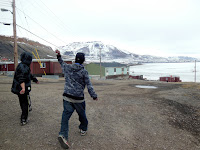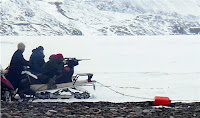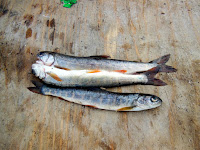Friday, June 5th was the last day of school for
students. Report cards would be handed
out at the end of the day and then students would be free to enjoy the next two
months of summer vacation. However,
several school "chores" needed to be completed first.
The students & teachers cleaned the area around the
school by picking up all the garbage.
Cigarette butts were left on the ground.
The garbage was very easy to spot because there was no snow. The school does have two large garbage bins
but they fill up quickly. We filled
quite a number of garbage bags with litter.
The school grounds looked a lot nicer than before. Littering & garbage being left on the
ground is a problem in all northern communities. I think the issue is that there aren't enough
public trash cans like the ones you see all over Iqaluit. Communities organize a cleanup day whenever
the snow melts in the late spring. It's
better than doing nothing.
 |
| My classroom at the end of the year. |
 |
| New textbooks, new resources. |
The morning was also spent cleaning classrooms. To make it easier for the floors to be swept
and vacuumed, chairs and desks were stacked up against a wall. Students were given the choice to collect their
class work or throw it out. My biggest
task was getting rid of all the outdated social studies textbooks. But, being a true teacher, I did keep one set
from each grade - (10, 11, & 12) - just in case. Some of the information was still valuable. Disposing the obsolete textbooks required
some heavy lifting. I was glad the
school has loading carts, otherwise, it would have been a slow, arduous march
to the garbage bins. I would be teaching
social studies next year with newly bought textbooks. The textbooks were written with the Alberta
curriculum in mind. (Nunavut's education
curriculum is based on the curriculums of Alberta and the Northwest
Territories).
The year-end festivities kicked off with the year-end
assembly after lunch. The entire
student-body gathered in the gym to witness the first important event on the
program: kindergarten graduation. The
back wall of the gym was decorated with large block letters, spelling, "Kindergarten
Graduates 2015". Purple and blue
stars surrounded the large title. The
blue stars contained the names of each individual graduate. A large wooden stage sat in front of the
decorated wall. The young graduates were
dressed in red graduation gowns and sat in the front row.
The principal and an Inuit student support assistant
opened the assembly by welcoming everyone in English & Inuktitut. They called upon Abby, the kindergarten
teacher, to come up and hand out the certificates to her students. When all the certificates were given, the
entire graduating class posed for pictures.
There were a lot of camera flashes and clapping hands.
 |
| Aga |
 |
| Spencer |
 |
| Michel |
Two members from the District Education Authority (DEA)
continued the assembly by announcing the teachers who would not be returning in
August and to give them a thank you/parting gift. Four teachers would not be returning: Aga -
high school arts; Spencer - Grades 7 & 8; Michel - high school math &
science; and Tootalik - Inuit sewing.
Aga & Spencer were moving to Alberta, Michel was returning to
Quebec, and Tootalik was retiring after teaching at Inuujaq School for many
years. Each teacher gave a short thank
you/farewell speech before accepting a final applause from the audience.
 |
| Tootalik |
 |
| Winner of the second bicycle. |
 |
| Winner of the iPad. |
The assembly moved on to the attendance awards where
names were drawn for the year end prizes.
Only those students who achieved perfect attendance for any month(s)
during the year were entered in the draw.
Three names were drawn for three prizes.
A lucky student from Kindergarten - Grade 3 would win a bicycle, a lucky
student from Grades 4 - 9 would also win a bicycle, and a lucky high school
student would win an iPad. Community
members & parents were called to draw names. There was much anticipation as the names were
drawn and cheers when the names were called.
Each winner came up to the front to receive their prize and to have
their pictures taken.
The afternoon festivities continued with a round-robin of
sports activities & BBQ. The
Year-End BBQ Committee had organized it so that not everyone was being served
food at the same time. We didn't do that
last year and it resulted in very long lines.
Students enjoyed the activities with their respective classes. High school was one large group. I escorted the high school students to each
activity station.
 |
| Competitive rock throwers. |
The first station was Inuit Games, led by Kataisee, Ikey,
and Tootalik. We only had time to play
the rock throwing game. It's a simple
game where you build small inukshuks with rocks and then knock them down by
throwing rocks. It's similar to horse
shoes but with more destruction. Whoever
knocks down the most inukshuks, wins.
You can alter the game by creating teams. You just have to make sure that everyone is
throwing rocks in the same, safe direction.
The second station was touch football, led by
Michel. Michel & I played with the
students. It was quite an intensive game
at several moments but in the end my team won.
 |
| HS students playing capture the flag. |
The third station was Capture the Flag, led by Greg, the
Grade 6 teacher. I took a break this
time and snapped pictures of the students running back and forth trying to
steal the flags without getting tagged.
The high school students were pretty competitive.
The fourth station was soccer. We played for a little bit but, by this time,
the high school students were hungry.
And thankfully, the BBQ lines were very short.
 |
| Year end BBQ. |
The BBQ station was set up behind the school. The station contained: four propane-fueled
barbecues, tables with condiments, buns, juice boxes, paper plates, &
napkins, and several garbage cans. The
hot dogs and hamburgers were prepared by teachers, several high school
students, and a few community members.
The food was delicious.
I spent most of the weekend packing my suitcase, cleaning
my residence, and emptying my fridge.
I was going to be out of town for two months so I had to make sure there
was nothing perishable left inside. I'm
pretty sure most of the southern teachers did the same. The packing must have been more challenging
for Aga, Spencer, and Michel because they were moving out. They made the task a little easier by selling
& giving away the possessions they would no longer need. I had my skidoo safely locked away in a
wooden shed at the Gas Station. The shed
belonged to Frank May, Arctic Bay's former mayor, and commanding officer of
3045 Army Cadet Corps.
The last day of school for teachers was Monday, June 8th. The principal gave out a checklist that
listed everything we needed to get done before we were dismissed for the
summer. We were already ahead of
schedule because we had recruited our students to help us clean out our classrooms the
week before. Some the tasks that needed
to be completed were: black & white boards must be wiped cleaned, all
posters in the hallways need to be removed, and any borrowed equipment must be
returned to the storage & resource rooms.
The last item on the list was handing in the keys to your classroom for
safe keeping.
A final staff meeting was called after lunch. The principal thanked everyone for making the
2014-15 academic year a success and personally thanked the outgoing teachers
for their contributions. We also
celebrated two staff birthdays with cake and snacks. At the end of the day, I handed in my keys to
the principal and wished him a good summer.
I spent the rest of the day packing.
All the southern teachers flew out on the morning of
Tuesday, June 9th. I got a ride to the
airport from Frank May. He also wished
me a great summer. As the First Air
turboprop lifted off the gravel runway and flew south towards Iqaluit, I
quietly thought about my planned adventures for the summer.
Another year living in Arctic Bay and teaching at Inuujaq
School has come to a close. As you can
tell, I will be returning for another year of teaching. With the summer now upon me, I will be taking
a break from my blogging duties. I can't
wait to tackle all the wonderful activities I've got planned in the coming days. You'll have to wait until August
to understand by what I mean.
Have a great summer and I'll see you all in August!



























































